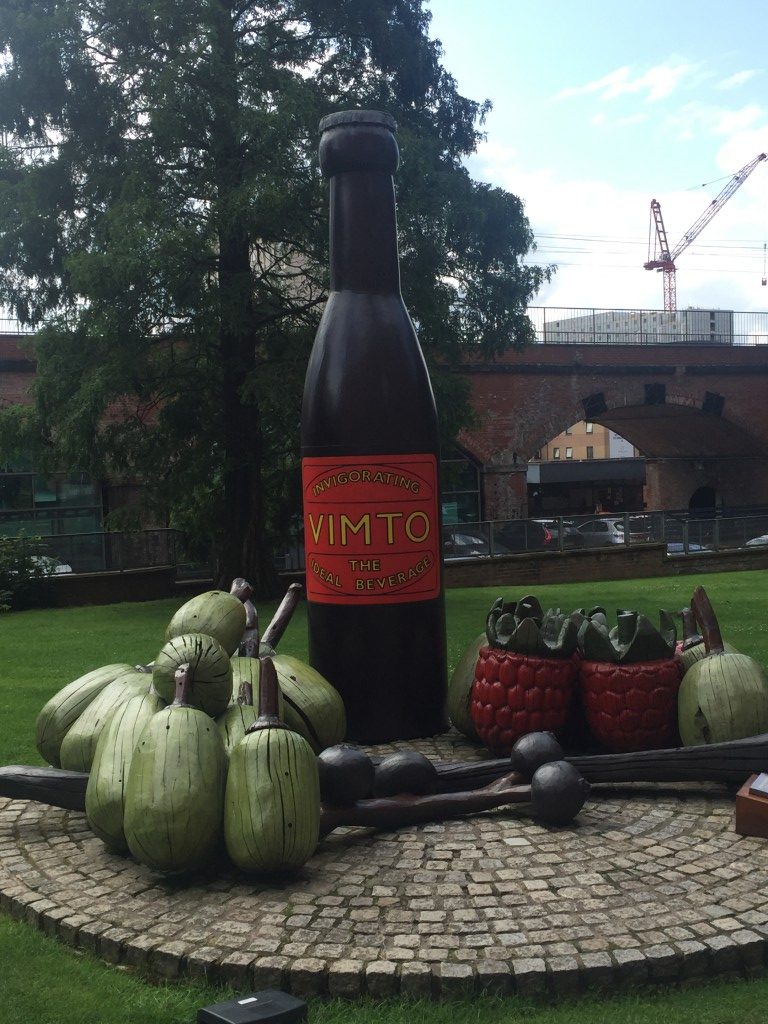A Manchester Food Tour in the Northern Quarter
A Manchester food tour in the Northern Quarter is the perfect way to explore this great city. But what is the Northern Quarter, and what makes it so good for a food tour?
Manchester’s Northern Quarter sits in the middle of Piccadilly and Ancoats. In recent years it has become the city’s trendiest area. A wealth of bars and restaurants have taken over. What was once a forgotten part of Manchester is now a must-visit.
The Northern Quarter is the creative heart of Manchester, and it offers dining experiences and activities suitable for all budgets. But more than the range of choices on offer or the wallet-friendly restaurants and pubs, the atmosphere of the Northern Quarter is what makes it so special.
As you explore this historic district, a sense of tradition and community spirit is always there.
If you’re interested in getting to know this area for yourself, why not join Manchester Bites for our Canals to Canapes Walking Food Tour in the Northern Quarter?
The Story of Manchester’s Northern Quarter
As with so many stories from Manchester’s past, we must begin with the Industrial Revolution, which was spearheaded in Manchester. The city’s first cotton mill was opened in 1783 in what would later become known as the Northern Quarter.
By 1853 this area had 108 mills and was a major hub of activity – the area was right bang in the centre of the industrialisation of Britain, a process that would, in time, affect the entire world.
People lived within very close proximity to each other. Freidrich Engels painted a bleak picture of the area, describing it as “dirty, old and tumble-down” in his work The condition of the working class in England. But for all its squalor, the area was hugely significant.
Manchester at this time was the engine room of the British Empire, and it was the working people of Manchester and similar industrial towns that kept everything in motion.
During Victorian times, the area became a popular entertainment spot. Tib Street was famous for its pet shops, and people would stroll up and down the road looking at all the animals on display.
The shops of the Northern Quarter would stay open late into the night, and with time the area came to be regarded as a bohemian centre.
In this cultural landscape, the Northern Quarter also gained a reputation for being a hotbed of political activity.
Manchester has long had a reputation for fighting for social justice and the Northern Quarter was the perfect place for preachers, workers, and political activists to make speeches to sympathetic (and occasionally hostile) crowds.
We strongly recommend checking out the People’s History Museum for anyone interested in Manchester’s political history.
The Decline Of The Northern Quarter
It was in the 90’s that the council devised the name Northern Quarter. Creative industries were encouraged to the In the wake of the senseless destruction of WWI, many of Manchester’s industries started to collapse.
Then after WW2, Manchester’s priorities had to be concentrated on rebuilding parts of the town destroyed by bombing and the Northern Quarter was largely neglected.
For much of the 20th century, the area’s story was economic decline. The factories and shops were closed to be replaced by cheap housing. And yet, the rough-and-ready charm of the place was what would eventually guarantee its revival and renovation.
In the 1990s, the Manchester music scene brought newfound attention to many of the neighbourhoods in Manchester that needed some love. And none benefited quite like the Northern Quarter. Suddenly the area was brimful with clubs, trendy boutiques, record shops, and cheap cafes.
The multicultural nature of the area would also lead to the opening of several restaurants specialising in international foods, such as the legendary This & That Cafe, which does some of the best curries in the whole city to this very day.
What Makes The Northern Quarter So Good For A Food Tour?
In the 90s, the local council devised the name Northern Quarter. Creative industries were encouraged to the area. Design businesses, architects, and start-ups made the Northern Quarter their home. The district recaptured some of that bohemian charm that had defined it during the Victorian period.
With such industries came great cafes and restaurants. What had been a quiet, forgotten part of Manchester was re-born.
The Northern quarter now has a plethora of food businesses to choose from. Asian, American, African, or old-fashioned, no-frills British food is all within a short stroll, and much more besides.
The buildings have been relatively untouched since the 18th century. So much so that the Northern Quarter is often used as the backdrop for films and tv series.
When you walk the streets of the Northern Quarter, you really get a sense of Manchester’s distinctive character; the architecture, eateries, cultural spaces, and, most importantly, people provide continuity, a connection to the area’s earliest days.
This mixture of the old and new makes the Northern Quarter the perfect place to enjoy an unforgettable Manchester food tour.
If you have any questions concerning our tours or services, please feel free to get in touch.
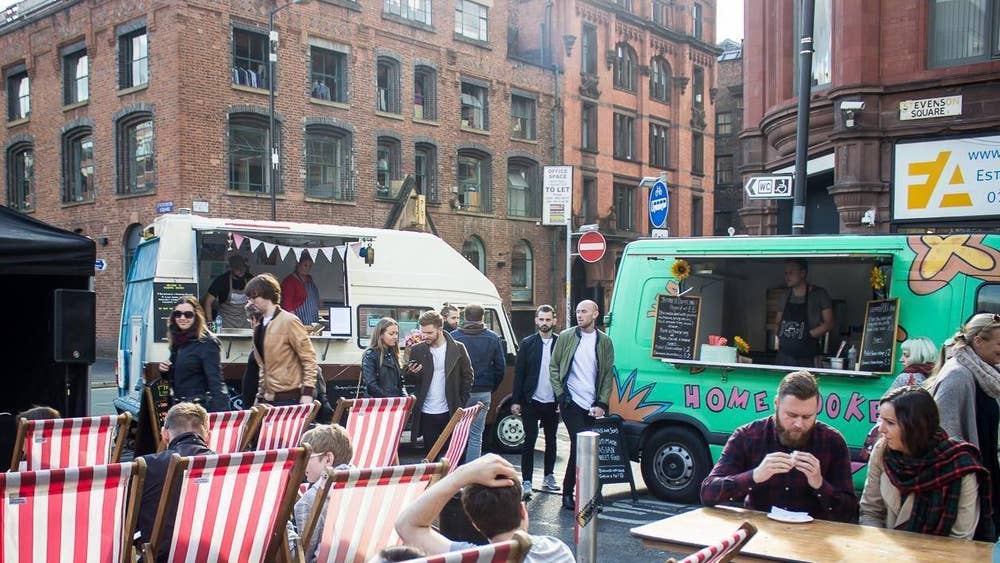
Bury black pudding. Another Manchester favourite.
If you’re visiting England for the first time you will definitely have to try an English breakfast. A good, old fashioned English fry up is a must try when you’re here. They are not the healthiest of things to eat. But they are perfect for a lazy Saturday morning. Especially when you’re in Manchester, as we claim to be the home of one of the most important ingredients.
Another Manchester food invention
One of the best things about a fried breakfast is black pudding. There’s a market town to the north of Manchester called Bury. It’s here where the Black Pudding was invented in 1810. It was probably invented a lot earlier than that but that’s the longest back we can trace it.
Black pudding is essentially blood sausage. It was common to use every single part of the animal back in the day. Not wanting to waste the blood, butchers created the black pudding. A mixture of pigs blood, cereals and seasonings are squeezed into pork skin. The sausage is then fried and served. It makes a perfect addition to an English breakfast. You can find different examples around the world. Morcilla in Spain and Blutwurst in Germany are both types of black pudding.
Where you can try the original Black Pudding in Manchester.
The market town of Bury is not as affluent as it used to be. It has a famous market there where you can buy black pudding. The Bury Black Pudding company is now the sole surviving business that still makes the pudding in Bury. You can visit their stall at the market. Or you can buy their puddings at major supermarkets around Manchester. If you want a really good breakfast experience we recommend here, https://www.thekoffeepot.co.uk/menus
Since the 1980’s there has been a black pudding throwing competition. The event is held in Ramsbottom near Bury. Contestants have to throw 3 black puddings at a stack of Yorkshire puddings. Whoever knocks the most Yorkshire puddings down wins. If you are in Manchester on the second Saturday of September you should go and check it out.
If you’re looking for a unique tour of Manchester, come and join our food tours. www.manchesterbites.com for more details

The story of Frank Sidebottom.
A Mancunian legend with a papier – mache head. But what is the story of Frank Sidebottom? Here we take a look at Frank’s creator Chris Sievey.
The days before Frank Sidebottom
Chris grew up in Sale which is a suburb to the south of Manchester. He was originally a musician although not a very successful one. He had partnerships with various musicians in the 70’s and 80’s. He started a band called The Freshies. They had some local success with a song with a fantastic name. I’m in love with the girl on the Manchester Virgin Megastore checkout desk. The record got to number 54 in the charts.
The creation of Frank Sidebottom
Frank Sidebottom was created in 1984. Frank was a 35 year old aspiring pop star who still lived with his mum. He lived in the south Manchester village of Timperley. Frank always dressed in a sharp suit but was most recognisable for his huge head. This was originally made from papier – mache and later fibreglass.
During the late 80’s and 90’s Franks popularity in Manchester grew. He would regularly appear on the comedy circuit and even had his own TV show. Frank Sidebottom’s fantastic shed show was first broadcast in 1992. He was a cult figure and would appear on late night music shows along top artists. Sometimes they didn’t know what to make of him.
One Manchester’s most unique statues.
Sadly Chris died in 2010 and with him took the story of Frank Sidebottom. In 2013 a statue of Frank Sidebottom was unveiled right in the heart of Timperley village. As you can see it is a pretty unique statue. Frank was afterall a pretty unique character.
You can visit Timperley and have a photo with the statue by taking the metrolink south. While you’re there make sure to pop into the Quarry Man pub. They do a great ploughman’s lunch.
Join our mailing list and keep up with all things Manchester. If you’d like to explore more of Manchester join our food tour. www.manchesterbites.com for more details.
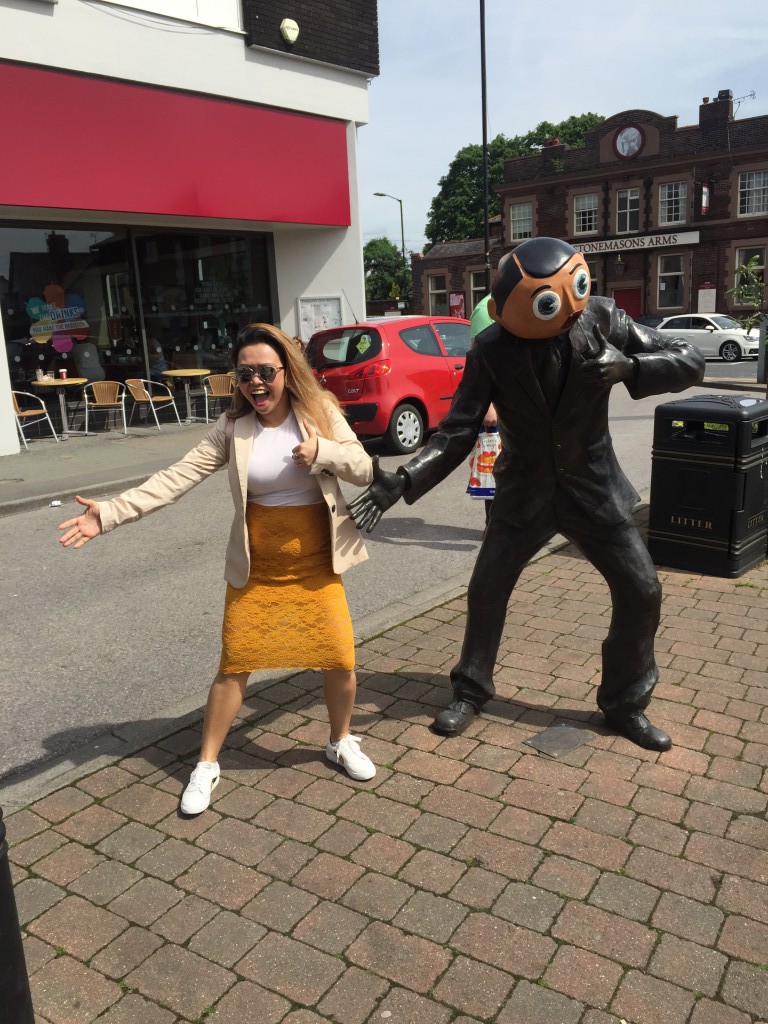
Manchester’s Free Trade Hall. And that Dylan concert.
We are lucky to have numerous historical buildings in Manchester city centre. One such building that you can visit is Manchester’s Free Trade Hall. Built in 1856 this grade 2 listed building stands on the site of the Peterloo Massacre. Originally the building was used as a meeting place for the local business community.
It had a vital role in the repealing of the corn laws. The corn laws meant that imports of grain, corn and wheat were taxed. This meant that landowners in Britain could charge a higher price for their corn. As a result it became more expensive to eat. Over time many urban centres such as Manchester rose up and rebelled against the law. The Free Trade Hall was Manchester’s epicentre for anti corn law demonstrations.
Fast forward to December 1940. Manchester was under attack from the German Luftwaffe. The Free Trade Hall suffered great damage. Only the frame of the building survived. In the 1950’s the hall was re-built behind the original outer wall.
A centre of Manchester’s music scene.
The Free Trade Hall became home to Manchester’s Halle Orchestra. In fact it continued to be their home right up until 1996. That is when the Bridgewater Hall took over. It wasn’t just classical concerts that the hall held. One of the most famous episodes in the hall’s history came in 1966.
Bob Dylan was touring the UK and at the time was causing quite some controversy. Dylan was using an electric guitar which was seen by many of his fans as distasteful. At a gig in the Free Trade Hall on 16th May, Dylan was heckled and called “Judas” by a concert goer. Many fans started to slow clap and some even walked out. Dylan kept going. He knew what he was doing was changing the face of music at the time. In 1998 Dylan released the recording of the gig. Manchester bands such as The Fall, The Smiths and Joy Division all say they were heavily influenced by this event.
Today the Free Trade Hall is a Radisson Hotel. You can still go in and admire the stunning entrance hall and enjoy a drink at the bar.
If you are interested to know more about Manchester and it’s incredible history, book a tour with us. Our food tours take in some of Manchester’s best local bites as well as a wealth of history and culture. To book a tour go to www.manchesterbites.com
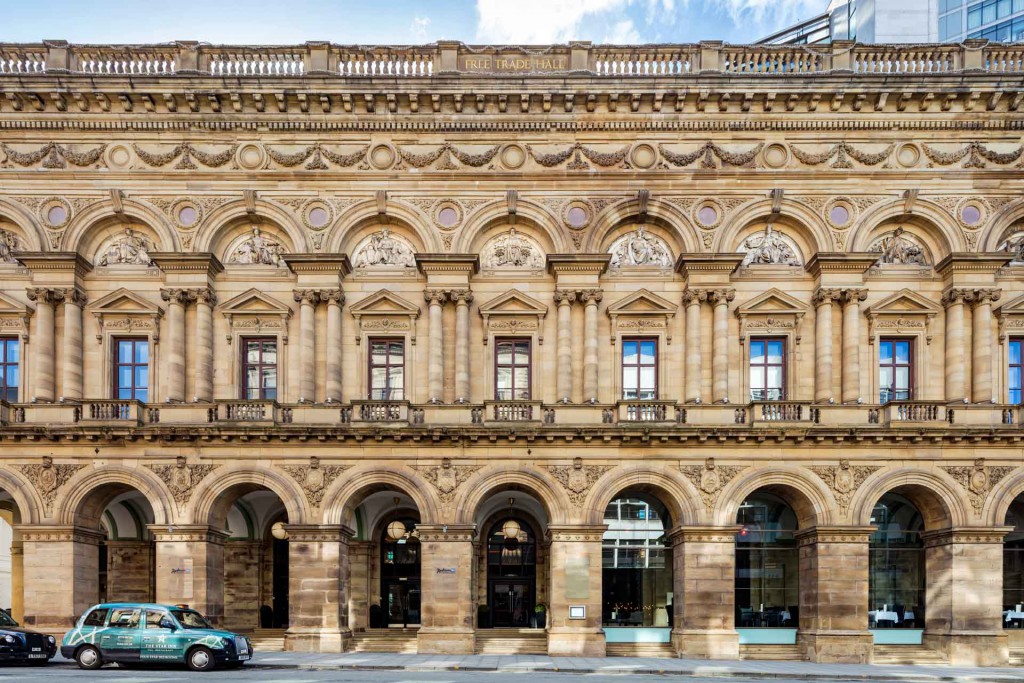
The Peveril of the Peak. A Manchester institution.
The Pev has been a Manchester institution for decades. It is known to many for its unusual 2 tone green facade. The tiles on the outside walls of the pub have led some people to describe it as an old toilet. But to those who know it, the Pev is one of the last proper drinking pubs in Manchester.
The pub dates back to the early 19th century. The name is said to have come from a stagecoach which used to travel between London and Manchester. The coach would stop off at the pub en route.
The Pev’s claims to fame.
It is the one of the only pubs in Manchester city centre that is detached, meaning you can walk all around it. This is due to the modernisation of the surrounding land. Where once there would be rows of terraced housing there are now shiny office blocks and towers. Now the Pev is almost on an island itself. In between Chepstow street and Bridgewater street.
The Pev also has the honour of having the longest serving landlady in Manchester. In January 2021 Nancy and Maurice will have been living above the pub for 50 years. They now have a much more hands off approach. The bar is now run by a younger team who have done well in keeping the spirit of the place in tact.
Like many of Manchester’s older pubs, the Peveril of the Peak has seen a few famous faces. It was used in the filming of Robbie Coltrane’s crime thriller, Cracker. It’s laid back, local atmosphere means that whoever you are you’ll get a welcome. Nowadays the Bridgewater hall is located a stone’s throw away.
Our historical pub tour of Manchester is a great way to spend an early evening. If you’d like to learn more about Manchester and it’s pubs go to www.manchesterbites.com

Vimto: A Manchester Innovation
Manchester has a long history when it comes to inventing things. The computer, graphite, commercial railways, indie music, football…the list goes on and on. One of our food and drink gifts to the world has been Vimto.
If you’ve never tried it, Vimto is a fruit-flavoured soft drink with true cult status. It contains grapes, berries and blackcurrants (and also, admittedly, lots of sugar).
In the UK we have a similar drink called Ribena. If you speak to anyone from Manchester you’ll realise that we are If Ribena is the UK’s most iconic berry flavoured drink, Vimto is the stylish person’s alternative choice.
Preferred in Manchester to just about any other soft drink, Vimto’s reputation across the rest of the UK tends to be defined by people who haven’t tried Vimto, and people who love Vimto and champion it at every opportunity!
A History of Vimto
At the start of the 20th century, a man called John Nichols used to sell herbs, spices and medicines in Manchester. He developed the recipe for what he called Vim Tonic. It was originally a medicinal drink but came to be regarded as a soft drink in 1913 and with that, the name was shortened to Vimto.
Due to the popular temperance movement of the period, which encouraged people to lead teetotal lifestyles, soft drinks were all the rage. And Vimto successfully made a name for itself within this culture.
It wasn’t, though, until the 1990s that Vimto really established itself as the trendy person’s booze-free tipple of choice. British culture in the 90s was defined by a slightly unruly, anti-establishment attitude. With Brit Pop acts like Blur, Pulp, and Oasis (yes, another Manchester export!) at the top of the charts, and anarchical TV shows like TFI Friday and The Word being watched by millions, anything too middle-of-the-road was, well, a bit naff.
Well, the marketing guys at Vimto had their finger on the pulse because the brand enlisted the perfect representative to advertise their brand: the slightly rude cartoon poet, Purple Ronnie. Created by writer and illustrator Giles Andreae, Purple Ronnie became a rogueish, much-loved figure on British TV, famous for his love of partying and innuendo-laden poems. One of his rhymes went as follows:
Vimto is a smashing drink
So why not have a slurp?
It’s full of fizzy bubbles
To make your bottom burp
In 2003, Purple Ronnie walked off into the sunset and Vimto adopted the new slogan “Shlurpling the Purple”.
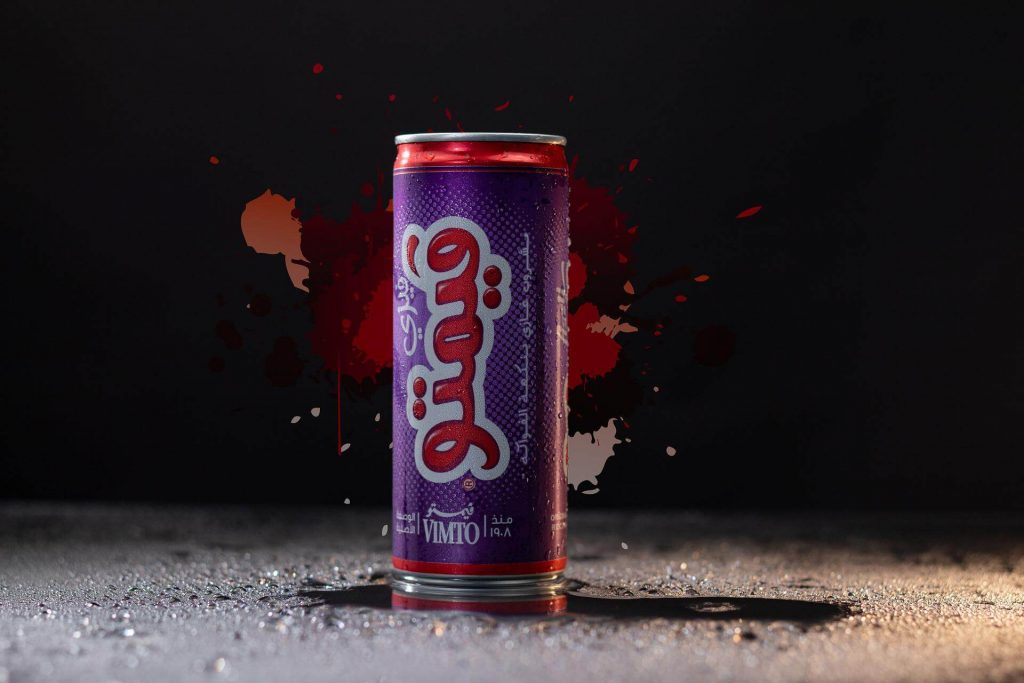
Vimto in the Middle East, and Around the World
Over the years the popularity of Vimto has gone from the Manchester streets to all around the world. An interesting tale relates to the Middle East and the Arabian Peninsula. During Ramadan, the drink becomes incredibly popular. This is probably due to the high sugar count helping people through their daily fasts. The Arabian Peninsula is the biggest foreign market and sales boom during the holy month, with the drink being the biggest selling beverage in certain countries.
Vimto’s popularity in this part of the world stretches back an impressive 80 years, and that popularity only seems to be growing.
Variations of the Drink
The good people at Vimto have never rested on their laurels, and throughout the drink’s history, many different varieties have been introduced. The standard Vimto is sold in both pre-mixed carbonated and cordial versions, with the latter being the more popular choice. In the winter months, the cordial version is often added to hot water to create a sweet, warming drink.
Through the decades Vimto has also released jelly babies, ice lollies, and other sweets featuring the distinctive brand flavour. And the drinks range often makes room for limited edition guest flavours, such as Cherry Vimto and Strawberry Vimto.
For those who haven’t been inspired by Vimto’s early temperance movement origins, you can use the drink as an inspiration and make a pretty moreish cocktail known as a Cheeky Vimto. Although the cocktail doesn’t feature actual Vimto as an ingredient, the blending of port wine and Blue WKD creates an alcoholic drink that captures something of Vimto’s unique berry blast.
Finally, if it’s sunny out, you may want to toss Vimto into a blender with ice cream and milk to create an indulgent Vimto milkshake.
The Vimto Statue
Anyone wanting to explore the culture surrounding Vimto in Manchester today should head to Granby Row in Manchester city centre where they’ll find a massive wooden sculpture of a Vimto bottle. This massive tribute to a Manchester classic is always a popular stop on our food tours of Manchester.
Would you like to learn more about Manchester and its incredible food scene? Are you looking for the best things to do in Manchester? If so, book a food tour with us and let us show you our city!
If you have any questions or comments regarding our tours, please get in touch.
